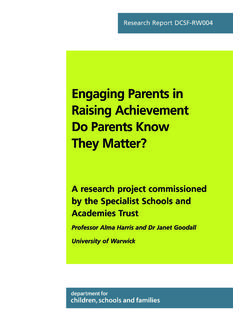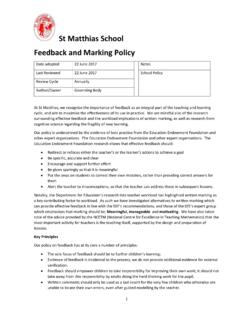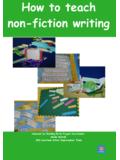Transcription of Narrative Writing Unit - Digital Education Resource ...
1 Narrative Writing unit Year 6 Planning Exemplification 2002 2003: Narrative Writing unit Contents Introduction 3. Framework objectives 6. unit plan for weeks 1 and 2 7. unit plan for week 3 8. Resource sheets 1. lesson notes for week 1, days 1 and 2 10. 2. Narrative framework for Writing 12. 3. Examples of types of Narrative Writing 13. 4. Checklists for effective Narrative Writing 14. 5. OHT Mac's short adventure 16. 6. Annotations for analysis: Mac's short adventure 21. 7. Planning frame for Bloddon's adventure 26. 8. Demonstration- Writing : Bloddon's adventure 27. 9a. OHT Child's Writing 32. 9b. Annotated Child's Writing 33.
2 9c. OHT Second child's Writing 34. 9d. Annotated Second child's Writing 35. 10a. OHT Birdman 36. 10b. Annotated Birdman 37. 11. Character web 38. 12a. OHT Mrs Wentleberry 39. 12b. Annotated Mrs Wentleberry 40. 13a. OHT Warehouse setting 41. 13b. Annotated Warehouse setting 42. 14a. OHT Action opening 43. 14b. Annotated Action opening 44. 14c. OHT ending of Action story 45. 14d. Demonstration- Writing : middle of Action story 46. 14e. Annotated middle of Action story 47. The National Literacy Strategy 2. Year 6 Planning Exemplification 2002 2003: Narrative Writing unit Introduction Preparation for this unit Prior to teaching this unit , it would be helpful for teachers to be familiar with the mark scheme for the 2003 Key Stage 2 Writing test.
3 Changes to assessment 2003: sample material for Key Stages 1 and 2 has been sent to all schools as a booklet and is also on the QCA website with some additional sample material The assessment focuses in the 2003 mark scheme are drawn together under strands: sentence construction and punctuation, text structure and organisation, composition and effect. These are the elements of Writing covered by the word, sentence and text level objectives in the NLS. Framework for teaching. Sentence construction and punctuation vary sentences for clarity, purpose and effect write with technical accuracy of syntax and punctuation in phrases, clauses and sentences Text structure and organisation organise and present whole texts effectively, sequencing and structuring information, ideas and events construct paragraphs and use cohesion within and between paragraphs Composition and effect write imaginative, interesting and thoughtful texts produce texts which are appropriate to task.
4 Reader and purpose The two word-level focuses are select appropriate and effective vocabulary use correct spelling The vocabulary focus is assessed through all the three strands and the spelling focus is assessed through a separate spelling test. Changes to assessment 2003: guidance for teachers (KS2 English) has also been sent to all schools. In order to understand the mark scheme, this booklet suggests comparing the 2002 sample materials with test papers from previous years using a script of a longer Writing task in the sample materials on the website, cutting up the annotated notes and matching them to the appropriate places in the script, the Narrative prompt A New World would be particularly helpful as preparation for this unit applying the strands from the mark scheme to the scripts giving the children a sample longer task using a prompt from the website, A New World.
5 And marking a selection of the stories with a colleague using the 2003 mark scheme. The National Literacy Strategy 3. Year 6 Planning Exemplification 2002 2003: Narrative Writing unit The unit In this Narrative unit , the resources for analysing texts and for demonstrating Writing have been annotated under the three strand headings: sentence construction and punctuation, text structure and organisation, composition and effect. The unit extends children's understanding of effective Narrative Writing by analysing and Writing each of the five parts of a Narrative text: opening, build-up, dilemma, events and resolution/ending and supporting the children in Writing their own Narrative .
6 While analysing the text and participating in demonstration lessons the children will learn how to construct sentences and paragraphs to achieve the effects needed to interest the reader. In the plenary, the teacher will have the opportunity to respond to the children's Writing with the three assessment strands in mind. During the first two weeks of the unit , two days will be spent on each element of Narrative as shown: Day Teaching/learning Element of Narrative 1 Read and analyse text opening 2 Apply this knowledge in demonstration and independent Writing 3 Read and analyse text build-up 4 Apply this knowledge in demonstration and independent Writing 5 Read and analyse text dilemma 6 Apply this knowledge in demonstration and independent Writing 7 Read and analyse text events 8 Apply this knowledge in demonstration and independent Writing 9 Read and analyse text resolution and ending 10 Apply this knowledge in demonstration and independent Writing The third week of the unit is an opportunity for children to write
7 Some aspects of Narrative such as setting and characterisation in more detail. Resources The resources for weeks 1 and 2 include lesson notes for the first two days of the unit , general material on Narrative structure, texts for analysis and texts to use to demonstrate Writing . All the texts are annotated to show the effective features of the texts. These are notes for the teacher to use as support during the analysis of the text with the children and as points to bring out during demonstration- Writing . (There is an alternative set of materials in Year 6 Planning Exemplification 1. 2001 2002 in the publications section on ).
8 Resources for week 3 of the unit include a number of shorter texts for analysis and demonstration- Writing as well as two pieces of Writing by children for assessment purposes. The National Literacy Strategy 4. Year 6 Planning Exemplification 2002 2003: Narrative Writing unit Resource Purpose sheets 1 lesson notes for days 1 and 2. 2 Narrative framework for Writing . This shows the five typical stages in Narrative Writing and could be enlarged as a poster. 3 Examples of types of Narrative . This shows the variations within the five Narrative stages. 4 Checklists for effective Narrative Writing . These are intended for teacher reference only.
9 Children should extract the features of effective Narrative Writing from the texts they analyse and compile their own classroom checklist with the teacher. The teacher can refer to Resource sheet 4 to ensure that the children have found all the features. 5a e OHTs of story in five parts: Mac's short adventure 6a e Mac's short adventure in five parts, annotated to show the effective features of Narrative Writing under three strand headings: sentence construction and punctuation, text structure and organisation, composition and effect. Some words which might be difficult to spell are also identified. 7 Planning frame for Bloddon's adventure 8a e Story for demonstration- Writing , Bloddon's adventure, in five parts, annotated with the effective features which can be identified by the teacher as he/she is Writing the story with the children.
10 Some words which might be difficult to spell are also identified. 9a d Children's Writing for assessment 10a b Writing a character 11 Writing a character 12a b Writing a character 13a b Writing a setting 14a e Writing an action story Word level work Word level teaching and learning is incorporated into the work on analysis of text ( meaning and spelling of connectives) and into shared, guided and independent Writing . However, focused spelling, like mental maths, needs concentrated daily attention so that Writing words correctly with a fluent hand is automatic and children's cognitive capacity is released to attend to the content and form of their Writing .













